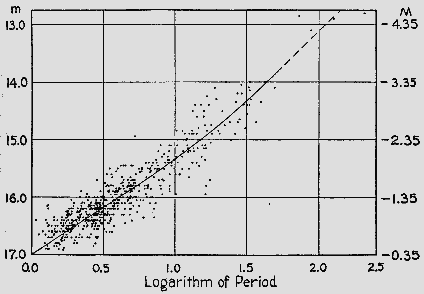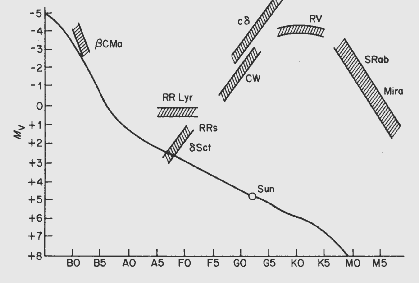|
THE
DISCOVERY OF CEPHEID VARIABLES AND THE PERIOD-LUMINOSITY
RELATION
-

INTRODUCTION
In 1784, John Goodricke
discovered that the star Delta Cephei varies
regularly in brightness over a period of 5 days, 8
hours and 48 minutes. Pulsating stars such as Delta
Cephei became known as classical Cepheids and are
vitally important to Astronomy.
|
Henrietta
Leavit and the Harvard women

THE HARVARD WOMEN.
HENRIETTA LEAVITT IS THE SIXTH FROM THE LEFT, AND
ANNIE CANNON IS THE FOURTH FROM THE
RIGHT.
Around the 1880's, the new
director of Harvard University Astronomy
Department, Edward Pickering, employed a number of
women for what was considered 'mundane' work.
However as these women (Henrietta Leavitt and Annie
Cannon amongst them) strengthened their science
skills it was soon realised that their input into
the astronomical world was invaluable. Henrietta
Leavitt discovered the period-luminosity law and
Annie Cannon lay the foundations of stellar spectra
classification.
|
Around 20,000
pulsating stars have been discovered to date with one woman,
Henrietta Leavitt accounting for around 10% of them. While
searching for changes in brightness of stars in the
Small Magellanic Cloud,
she noted that the brightest variables also had the longest
periods.
Leavitt plotted around 2000 of these Cepheids using their
apparent magnitude and the logarithm of their period and
discovered what is called the Period-Luminosity
relation.

This diagram
shows Henrietta Leavitt's graph of data for the
SMC
The stars in the SMC
can be considered to be at the same distance, so their
absolute
magnitude must
change by the same factor. Having both a stars absolute and
apparent
magnitude
gives astronomers an estimate of its distance from
us.

or

The only problem with
all this was the calibration of the Period-Luminosity law.
All the visible Cepheids at the time had unknown distances
because the parallax
method normally used could not resolve the minute changes in
position of the star. However in 1913, Ejnar Hertzsprung
managed to calculate the distance to the Cepheid 'Polaris'
as 200 Parsecs.
He did this by combining statistical methods with the
parallax produced with the Sun's path through space. The
Period-Luminosity relationship was thus properly
formulated.

or in terms of Absolute
magnitude:-

Where:
 =
Luminosity of Cepheid star. =
Luminosity of Cepheid star.
 =
Luminosity of Sun. =
Luminosity of Sun.
 =
Period of Cepheid star (in days). =
Period of Cepheid star (in days).
 =
Mean Absolute magnitude of Cepheid star. =
Mean Absolute magnitude of Cepheid star.
A number of studies of different
galaxies has produced a more clearer picture of the
Period-Luminosity law as shown here:-

Types of Cepheid
Variable
There are more than 700 Cepheids in
our galaxy, and all fall into two main categories. Firstly
there are the Classical Cepheids whose typical star is Delta
Cephei and are Population one stars. Then there are what are
called W Virginis stars. These are Population two stars and
are denoted by the letters CW.

This diagram shows the
locations of both Classical Cepheids (denoted by c delta)
and W Virginis (denoted by CW) stars on the
Hertzsprung-Russell diagram.
Exercise-
Determine The Distance To NGC 7331
|





![]()



![]() =
Luminosity of Cepheid star.
=
Luminosity of Cepheid star.![]() =
Luminosity of Sun.
=
Luminosity of Sun.![]() =
Period of Cepheid star (in days).
=
Period of Cepheid star (in days).![]() =
Mean Absolute magnitude of Cepheid star.
=
Mean Absolute magnitude of Cepheid star.
